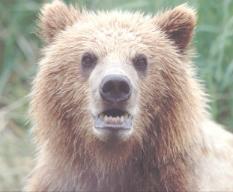
KALISPELL, Mont. -- A grizzly bear accidentally shot and killed by a hunter in north-central Idaho last month likely migrated south from the Selkirk Mountains, crossing two highways and traveling farther than any other bear is known to have moved, federal officials said.
The trip was at least 140 miles as the crow flies, but likely much longer on the ground. "It's absolutely remarkable," said Chris Servheen, grizzly bear recovery coordinator for the U.S. Fish and Wildlife Service. "I was so shocked that I immediately called the geneticist and said there must be some mistake. But there's no mistake. This bear moved more than twice as far as any other we've seen."
The grizzly bear was shot on Sept. 3 near Kelly Creek, three miles west of the Montana border, west of Superior. A Tennessee hunter mistook it for a black bear. The last time a grizzly bear had been seen in that area was 1946. Servheen had long predicted bears might roam back into that region, a place he calls "excellent grizzly bear habitat." Still, the shooting was a surprise.
Servheen figured the bear had roamed out of the Northern Continental Divide Ecosystem - an area running from Glacier National park through the Bob Marshall Wilderness - or maybe down from the Cabinet Mountains near Libby. DNA analysis on the bear's tissue determined it was similar to bears in the Selkirk Mountains in northern Idaho. Wildlife managers speculate the bear could have migrated from the Priest Lake region north of Sandpoint, Idaho. That means the bear crossed U.S. Highway 200 and Interstate 90, and traveled at least 140 air miles, who knows how many ground miles. Scientists call bears that really roam "great movers," and they usually travel 60 or 70 miles, Servheen said.
The bear's journey points to the importance of protecting corridors between areas of grizzly bear habitat, Servheen said.
Servheen said the bear did not have a GPS collar, so he doesn't know the precise route the bear took from the Selkirks, why it left its relatively unpopulated home range and why it kept moving through so much perfectly habitable habitat in between. "It would have been so amazing to see where he went and how he got there," Servheen said, "how he crossed I-90."
The location of the 400-pound bear bolsters Servheen's argument that researchers should begin actively looking for more grizzly bears in the Bitterroot Mountains on the Montana-Idaho border. He expects that search will begin next summer, with the use of barbed wire traps to snag hairs from unsuspecting grizzlies.
